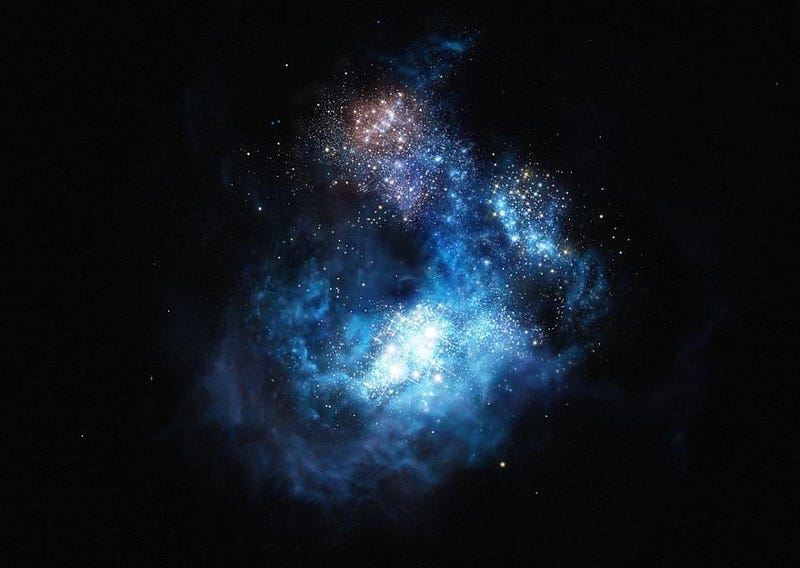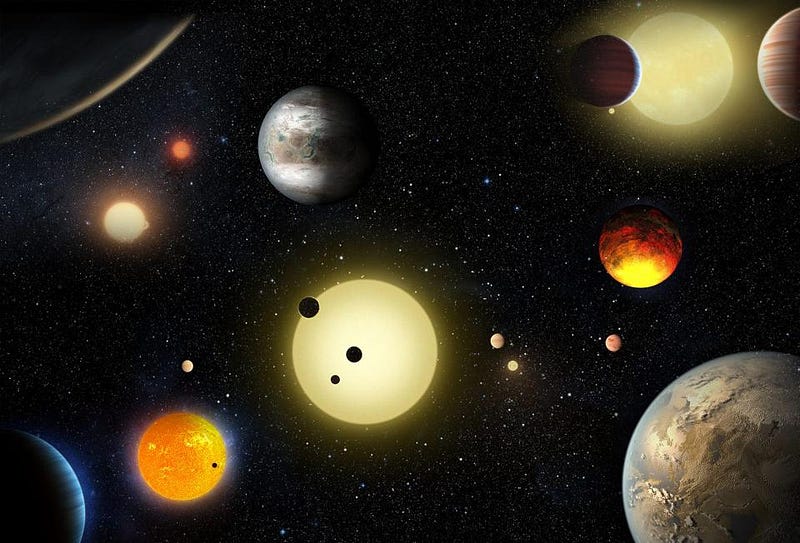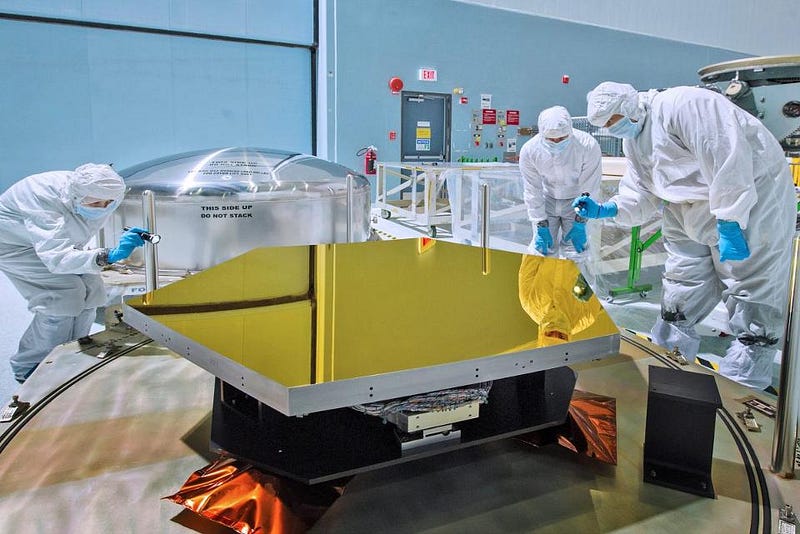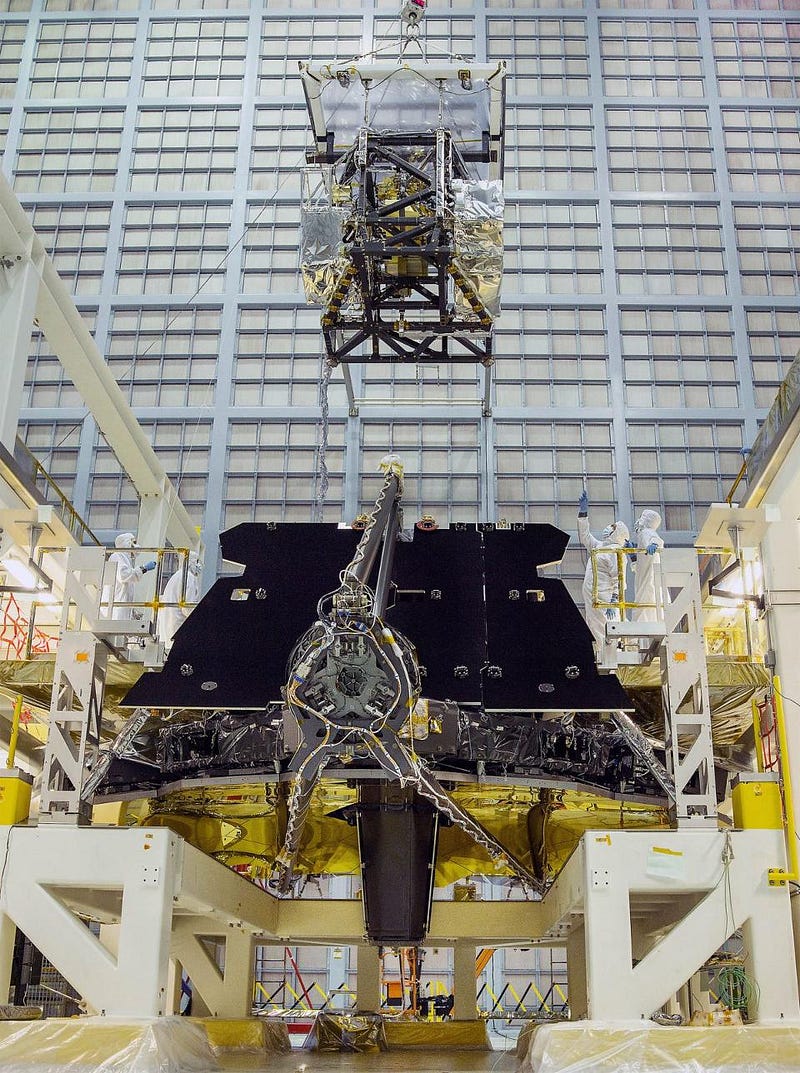How NASA’s James Webb Space Telescope will answer astronomy’s biggest questions

A live-blog event of an incredible public lecture by a scientist on the inside of James Webb’s team.
“The [James Webb] telescope is basically designed to answer the big questions in astronomy, the questions Hubble can’t answer.” –Amber Straughn
In 1990, the Hubble Space Telescope began operations, making it the first great NASA observatory, capable of seeing to the far reaches of the distant Universe. It’s shown us what our Universe looks like today, and how it’s changed and grown over billions of years. It showed us how galaxies were different billions of years ago, and uncovered the faint, distant galaxies that shaped our Universe today. But there are a number of questions it can’t answer:
- What were the first stars and galaxies like?
- How do stars come to form deep within a dusty nebula?
- What are the atmospheres of Earth-sized worlds like, and do they contain signatures of life?
- How far away do we need to look to see the pristine, pre-stellar Universe?
- And how did the early stars and galaxies assemble to give rise to what we have today?
For these questions, it will take a revolutionary new observatory. It will take the James Webb Space Telescope.

Hubble is incredible, but it’s also limited. With a primary mirror of 2.4 meters, it only has 1% the light-gathering power of the most powerful ground-based telescopes under construction today. Since it’s close to the Earth, it receives heat from our planet, and so can only see into the infrared a little bit; it’s mostly restricted to the same types of light human eyes can see. And given that the Universe is expanding and the radiation within it gets shifted towards the redder, longer wavelengths, there’s a fundamental limit to how far back we can see.
Unless, that is, we build an infrared observatory, with a much larger mirror, and send it into space far from Earth, where it’s shielded from the Sun and can reach very cold, cryogenic temperatures.

That’s the exact plan of NASA’s James Webb Space Telescope, launching next year. The 18 gold-coated mirror segments provide seven times the light-gathering power of Hubble, but with only half the weight. Its orbital location, at the L2 Lagrange point so distant that both the Earth’s and Moon’s shadows have ended, means it won’t have to contend with any of the contamination you get from being in low-Earth orbit. The novel sunshield design provides passive cooling, placing the “cool” side at liquid nitrogen (~77 K) temperatures without any need for that coolant. And the infrared capabilities that come with it mean that ultra-cool, ultra-distant and ultra-faint signals can be teased out of the Universe for the first time.

We should be able to measure the first stars and galaxies to a precision never seen before. We should break the cosmic record for the farthest stars and galaxies, and they should appear to us everywhere we look in space. We should be able to measure the atmospheric contents of Earth-like planets around the smallest, lowest-mass stars, including all the worlds around TRAPPIST-1. We should learn how the Universe became transparent to visible light, thanks to the radiation from the earliest galaxies. And we should be able to infer so much about the first stars, perhaps even including when they winked into existence for the first time.

Hubble taught us what our Universe looks like; James Webb will teach us how our Universe came to be this way. It’s the next great remarkable step, it’s an incredible feat of engineering and it represents just as big a step up from Hubble as Hubble was from ground-based telescopes.
At 7 p.m. Eastern Time (4 p.m. Pacific Time) on March 1, 2017, scientist and astronomer Amber Straughn will deliver a public lecture at the Perimeter Institute on the future of astronomy with James Webb. She’ll tell us where we are in the process of building it (complete), testing it (undergoing launch simulations), and whether we’re on schedule or not (should launch as planned in October of 2018). She’ll tell us what we’ll hope to find, measure, and how we’re going to do it. And she’ll be available to take questions from all over the world; just tweet at any time during the lecture with the hashtag #piLIVE. Watch it here, either live or any time afterwards.
And I’ll be here to provide an expert live-blog commentary, running in real-time right alongside the broadcast. Tune in and refresh your page, and I’ll be providing updates (and fact-checks) every few minutes for you!
(All times Pacific Standard Time, PM.)

3:50 — Welcome to the live blog of Amber Straughn’s public lecture at Perimeter Institute! Fun fact: James Webb will launch at dawn, ensuring that it’s always in the Sun. In fact, there will only be a 30-something minute window where it needs its batteries; the rest of the telescope’s entire operations will be powered by solar panels!

3:54 — Will Webb be able to detect exoplanets? In a way, it will be the best telescope for it ever! By having such a large-diameter mirror in space, we can measure the transits of Earth-sized (or even smaller) planets around the smallest, most common class of stars: M-dwarfs. When a transit occurs, we should be able to break the absorbed light up into spectra, telling us what the atmosphere is made of! Is there molecular oxygen? Methane? Carbon dioxide? Other organics? Webb will find out!

3:58 — Amber’s story of how she got interested in space, science and astrophysics is so similar to the story of so many other scientists. It’s all about curiosity, wanting to know, and the willingness to put in the work to find out!

4:01 — Perimeter is so amazing for putting this on, and for delivering such inspiring messages about science. “There has never been a better time to be… part of the equation.” So dorky, but so true!

4:04 — It’s important to realize that scientists are people, and they are introducing Amber, who’s been a public face for science and astrophysics as well as a legit scientist… including for Jimmy Fallon. Not bad!

4:06 — For someone who grew up in rural Arkansas, stunned by the night sky (pretty pristine), she was innately curious. And when she asked her mom a question she couldn’t answer, it was a big deal that her mom told her, “I don’t know, but you can figure it out.” And decades later, that’s exactly what she’s doing. That’s a wonderful message, and it’s a message that should resonate with each and every one of us. We can figure it out; all we need to do is ask the right questions in the right ways!

4:08 — What makes James Webb so incredible? Well, none of the questions we’re asking would even be possible without the work and discoveries of Hubble — the telescope — that’s provided view about the Solar System, the Milky Way, and other galaxies outside the Milky Way (plus the evolution of the Universe as a whole), and it’s helped shape the picture of the Universe we have today. The questions we’re asking now wouldn’t be possible without this knowledge.

4:10 — And the best thing of all? To Amber, and (probably) also to me? The Hubble deep field images. The eXtreme Deep Field (XDF), with 23 days of observing time, is almost twice as deep as the Ultra Deep Field Amber references. We see 5,500 galaxies in a region just 1/32,000,000th of the entire sky! And yet, there are even more galaxies out there that Hubble can’t see. It’s incredible, and it’s so incredible that it’s even brought astronomy and the Hubble Space Telescope’s imagery into popular culture around the world.

4:13 — Really loving the plug for education and public outreach that Amber is pushing here. It’s about inspiration, it’s about knowledge, it’s about beauty, but even she isn’t sure of why people are captivated by these things that are outside of our experience. She doesn’t have the answer, but I think I do: they connect us to what we long for, but what we cannot and have not experienced for ourselves. They are the closest brush we have with the limits of existence, and with the unknown. In our own way, it allows us to experience the un-experience-able.

4:15 — Why is James Webb so much better than Hubble? Well, it gathers more light (about seven times as much), but its extra size also means better resolution! The “seeing” resolution of a telescope is governed by how many wavelengths of light can fit across the primary mirror, and if you’re looking at the same, fixed, infrared wavelength, JWST can see more than twice as well as Hubble can!

4:18 — So, you saw that famed Hubble image of the Pillars of Creation? (Above.) It took an infrared one, too. And that’s a preview of what James Webb will see. What does that look like? See below:

Incredible!

4:20 — What are the first galaxies like? When did they form? Do they have black holes? How do they cluster? And when do they turn “on” enough to reionize the Universe, and make it transparent to visible light? These are the science questions that James Webb was designed to answer, and why it has the technical specifications and wavelength sensitivities that it was built to have. It should be able to measure back to when the Universe was just 200–275 million years old: around 2% of its current age. (Hubble’s most distant galaxies ever are 400–600 million years old. That’s a big difference!)

4:22 — How can James Webb see so far? Well, it will be helped by gravitational lenses: the massive clusters that can magnify the light from background galaxies behind them. This happens even in the infrared, even in the very early Universe. Einstein helps us out even in the most extreme cases!

4:24 — Keep in mind that we already have seen how galaxies grow and merge for about 12 billion years; we have great data on that from Hubble and other telescopes/observatories. James Webb will be special for really shedding light on those first 1–2 billion years of galaxies. While that’s incredible and worth celebrating, don’t forget what we already know; that’s incredible too!

4:27 — This is another beautiful illustration — from Hubble, again — of how looking in the infrared can shed light on star formation. Sure, it looks like there’s a star in the optical (top), but by looking in the infrared you can see the stars themselves! Incredible!

4:29 — Amber it talking now about the Kepler spacecraft, exoplanet finding and transits. But what JWST will do goes far beyond anything Kepler did! Why? Wavelength, size of the telescope and the instruments on board it. Kepler gave us a huge variety of exoplanet systems, but the ability to measure their atmospheres down to small sizes — including for signs of water, clouds, aerosols and organics — will fall to James Webb. For those of you wondering, Hubble can see atmospheres of Saturn-sized worlds around Sun-like stars; JWST will see worlds 1.5 times the size of Earth around Sun-like stars and Earth-sized worlds around M-dwarfs, the most common class of stars in the Universe. It goes from “knowing that they’re there, to knowing what they’re like.” (As Amber says.)

4:32 — Habitability? You’d have to get really, really luck to have a planetary system that we find that is inhabited… but sometimes, we do get lucky. After all, we have TRAPPIST-1, with three potentially habitable Earth-like planets. And the speculation is intense, and there are lots of reason to think they might be barren… but we have to look. 40 light years away, 7 Earth-sized planets, 3 of which may be habitable. How can you not look?!

4:35 — Most people don’t get excited about spectra. Why? Because doing spectroscopy doesn’t deliver the spectacular images that photometry does. It takes longer, it’s just a series of lines and bumps, but it delivers far more science than the pretty images ever can. I have a hunch — and this is me, not Amber talking — that we’ll be developing new methods of visualization to better “see” what JWST is delivering. And oh, will it ever deliver so much science!

4:37 — You have to realize that the mirrors will reach “high” temperatures of over 300 K, but will be “cooled” down to below-liquid-nitrogen temperatures on the cold side. You have to contend with thermal expansion (and contraction), and that’s part of why the mirrors are so incredibly precise: when they’re successfully deployed, across around 6 meters, the biggest “bump” on the mirror is about 20 nanometers, or about 3% the size of the wavelength of the light you typically see from the Sun. That’s pretty incredible!

4:40 — It’s important to recognize that this is truly an international collaboration! NASA, JAXA (Japan), ESA (Europe), the CSA (Canada) and more are all involved! And you need that if you want to build the greatest telescope/observatory of all time. Science, you must remember, and the knowledge we reap from it is for the benefit of all humanity!

4:43 — One of the coolest things you might not realize about the sunshield on James Webb? It has to be packed into a rocket, where the diameter of the rocket is no bigger than one of the mirror segments. But look at how big that sunshield is! Monumental challenges included how to vent the heat (out of the sides), how to evacuate all the air during launch without ripping the shield, how to make holes that align while it’s stowed but don’t overlap while it’s deployed, and how to fold the sunshield to eliminate the possibility of a snag during deployment. The ultimately successful design was a culmination and a combination of modern simulations/calculations, and old-fashioned pattern/sail/dress-making techniques; it was a unique mix of cutting-edge technology and artistry.
Not bad for what is really, at the end of the day, just five sheets of coated plastic.

4:45 — It’s worth noting that the sunshield gets you incredibly far! In direct sunlight, the “hot” side of the sunshield gets up to about 350º C (662º F), or hot enough to melt lead, while the cool side, on the other end of the five layers, needs to be colder than liquid nitrogen (77 K). But what’s even more amazing is that we do have cryogenic cooling on board — active cooling — for the mid-IR (as opposed to the passively cooled near-IR) wavelengths, that take the telescope down to just a few degrees above absolute zero. Why? Because things get less noisy at cold temperatures!

4:48 — Fun stuff: we did vibration testing on the telescope to simulate the stresses it will experience during launch. And in order to do so, we had to build a custom vibration table, because we’d never needed to shake anything this big before!
https://www.youtube.com/watch?v=bTxLAGchWnA
4:50 — How long does deployment take? You might think that watching a five minute video is slow, but the whole deployment process — beginning with the Solar Panels and culminating with beginning the science alignments — takes 14 days. Incredible!
4:52 — It’s a very nerdy thing to get excited about, but the sign that NASA’s James Webb is real? There are calls — out now — for scientific proposals. You don’t do that unless you have a telescope going up. That’s right, folks; this is real!!!

4:54 — This is also really nice: Amber reminds us that this isn’t all about James Webb. That’s just one of the NASA observatories (although perhaps the most exciting of the decade), but WFIRST will basically do what Hubble does, except with an incredibly wide field of view. It will basically cover the whole sky with Hubble’s depth!
4:55 — “In the end, these missions that we build are about the promise of discoveries.” There are untold surprises out there, and that will be the biggest achievement of all: discovering not just what we anticipate, but discovering what’s truly unknown. Nice way to end the talk!
4:57 — I have to be really, really happy about a talk like this, where I can’t point to a single thing that Amber said that was controversial, that misinterpreted what we know or that would lead the audience into thinking that speculation was fact. She nailed it!
4:59 — And if you want dark energy, that’ll be WFIRST’s specialty. If you want the first galaxies, that’s James Webb. These great observatories are complementary, rather than competitive. If we observe the same portions of the sky with these different observatories, the riches are knowing that much more about an object or phenomenon. Multi-wavelength astronomy is why we have multiple great observatories! After all, look at what composites have brought us so far:




It’s really worth it.
5:02 — I was hoping we’d get a question about James Webb and gravitational waves, and unfortunately we didn’t get one. But if we have four or five different gravitational wave detectors going at once — the twin LIGOs, VIRGO, KAGRA and the one India’s promised to build — perhaps we can truly pinpoint the location of a black hole-black hole merger to within Webb’s accuracy. We don’t think there should be a visible/IR signature, but like Amber said, we have to look if we want a chance to be surprised!
5:04 — And after a great Q&A, I’m going to call it a day. Thanks for joining us, for reading along and for listening to Amber’s phenomenal talk. Well done, everyone involved!
This post first appeared at Forbes, and is brought to you ad-free by our Patreon supporters. Comment on our forum, & buy our first book: Beyond The Galaxy!





